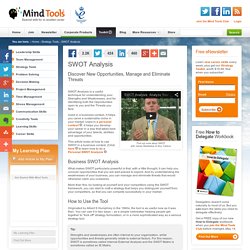

SWOT Analysis Part 1. Discover New Opportunities, Manage and Eliminate Threats Find out more about SWOT, with James Manktelow & Amy Carlson.

SWOT Analysis is a useful technique for understanding your Strengths and Weaknesses, and for identifying both the Opportunities open to you and the Threats you face. Used in a business context, it helps you carve a sustainable niche in your market. Used in a personal context , it helps you develop your career in a way that takes best advantage of your talents, abilities and opportunities. This article looks at how to use SWOT in a business context. Business SWOT Analysis What makes SWOT particularly powerful is that, with a little thought, it can help you uncover opportunities that you are well-placed to exploit. More than this, by looking at yourself and your competitors using the SWOT framework, you can start to craft a strategy that helps you distinguish yourself from your competitors, so that you can compete successfully in your market.
How to Use the Tool Tip: Swot Analysis Part 2. Developing Strategic Options From an External-Internal Analysis © iStockphotoNormunds TOWS Analysis is a variant of the classic business tool, SWOT Analysis.

TOWS and SWOT are acronyms for different arrangements of the words Strengths, Weaknesses, Opportunities and Threats. By analyzing the external environment (threats and opportunities), and your internal environment (weaknesses and strengths), you can use these techniques to think about the strategy of your whole organization, a department or a team. You can also use them to think about a process, a marketing campaign, or even your own skills and experience. Our article on SWOT Analysis helps you perform a thorough SWOT/TOWS Analysis.
In this article, we look at how you can extend your use of SWOT and TOWS to think in detail about the strategic options open to you. Identifying Strategic Options SWOT or TOWS analysis helps you get a better understanding of the strategic choices that you face. Example FMEA report. FMEA - Failure Mode and Effects Analysis, FMECA. Failure Mode Effects Analysis (FMEA) Also called: potential failure modes and effects analysis; failure modes, effects and criticality analysis (FMECA).

Failure modes and effects analysis (FMEA) is a step-by-step approach for identifying all possible failures in a design, a manufacturing or assembly process, or a product or service. “Failure modes” means the ways, or modes, in which something might fail. Failures are any errors or defects, especially ones that affect the customer, and can be potential or actual.
“Effects analysis” refers to studying the consequences of those failures. Failures are prioritized according to how serious their consequences are, how frequently they occur and how easily they can be detected. Failure modes and effects analysis also documents current knowledge and actions about the risks of failures, for use in continuous improvement. Begun in the 1940s by the U.S. military, FMEA was further developed by the aerospace and automotive industries. What follows is an overview and reference. FMEA Example. Lean Software Engineering. What is a Pugh Decision Matrix?

A simple tool for methodically making a choice from several alternatives. It can be easily done with any spreadsheet. The technique often called Pugh Concept Selection. “Pugh” comes from its originator, Stuart Pugh. When is it most useful? If you … Have an important decision for which you’re waffling between several viable choicesHave a decision that has split your team into camps with no consensus and poor buy-inHave a design decision or policy that keeps being attacked or reconsidered, months or years down the roadAre using Set Based Development — exploring several design alternatives, looking to pick the final choice for this version of the product at the “last responsible moment” Example This example is looking was looking at alternatives for buying a cellphone here in the US in early 2007. Process The basic steps of the Pugh Concept Selection Process are Brainstorm alternatives, list them across columns of sheet.
Blank Template More Background. Pugh Matrix. PUGH Analysis Template.